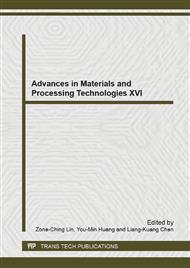p.570
p.577
p.584
p.592
p.600
p.609
p.615
p.623
p.630
Generalized Two-Point Method for Straightness Profile Measurement - Error Propagation and Experimental Results
Abstract:
In the straightness profile measurement of a mechanical workpiece, hardware datums have been the traditional standard. However, when the straightness profile is measured using a scanning displacement sensor set on an X-stage as the hardware datums, output of a displacement sensor includes the signal of straightness profile and the sensor’s parasitic motion, i.e. straightness error motion. Then, error separation techniques of the straightness profile from parasitic motions have been developed. For example, two-point method uses two displacement sensors and separates the sensor’s straightness error motion from the straightness profile. However, the conventional two-point method cannot measure a large-scale workpiece because the large sampling number causes random error amplification. In this article, the influence of the random error of generalized two-point method is shown. As the result of the theoretical analysis and numerical analysis, random error propagation decrease when sampling number increase. Further, experimental results obtained by generalized two-point method with large sampling number are analyzed using Wavelet transform and influence of error of the generalized two-point method is discussed in the space-spatial frequency domain.
Info:
Periodical:
Pages:
600-606
Citation:
Online since:
May 2014
Authors:
Keywords:
Price:
Сopyright:
© 2014 Trans Tech Publications Ltd. All Rights Reserved
Share:
Citation:


